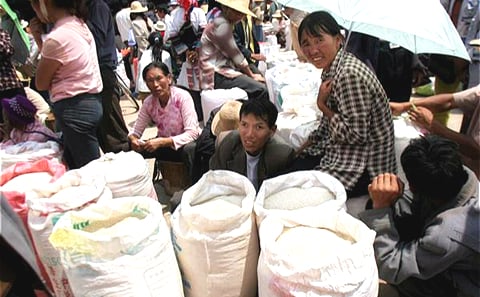When permits for Chinese researchers to grow genetically modified rice and corn expired this summer, there was concern. More so, given there was little indication that the Ministry of Agriculture would renew them.
The certificates, issued in 2009, concerned two types of Bt rice, which express a gene of the bacillus thuringiensis bacterium, conferring pest resistance, and phytase maize, which when used as feed can increase the uptake of phosphorus in pigs and chickens. This in turn can lead to energy savings and more efficient land use. Though not the only homegrown transgenic crops, these projects had attracted particular attention, both for their potential to produce path-breaking examples of Chinese “indigenous innovation”, and for the perceived risks of altering such culturally resonant staple crops.
Making sure people have enough food on the table is a political priority in most countries, but it is hard to overstate its importance in China, with one-fifth of the world’s population and only 8% of its arable land, and where famine, scarcity and rationing are all-too-recent memories for the leadership. In 2014, for the 11th year in a row, China’s first central policy document of the year concerned rural development.
For many years, agricultural biotechnology has been a significant government priority: it is, for example, one of seven “Strategic Emerging Industries” in China’s latest Five-Year Plan. Furthermore, China has in recent decades seen a massive increase in the production, sale and consumption of meat; phytase maize, in particular, represents an innovation geared towards increasing the efficiency and reducing the environmental costs of this expansion.
So, why were the certificates allowed to lapse before the crops could be commercialised? No clear answer has emerged, but media reports suggested four possible explanations.
First, some pointed to the economics: in the case of Bt rice, Huang Jikunnotes that China has nearly reached self-sufficiency in producing rice with conventional varieties, suggesting the ministry decided there was little need to commercialise GM rice in the near future. Second, others chalked it up to “social stability” concerns, with a Greenpeace official telling ScienceInsiderthat “public concern around safety issues” played an important role. This same campaigner suggested a third explanation, that problems with regulation — “loopholes in assessing and monitoring [GM] research” — underlay the decision, too.
Finally, Cong Cao, an associate professor at University of Nottingham,suggested a fourth explanation: simply put, delusions of an ultranationalist variety. For Cao, the u-turn can be blamed on “outrageous” notions — apparently held by some military and other elite figures — that GM food is a “devious plot to annihilate the Chinese”, disseminated by an “anti-GM movement whose power and influence are more than matched by its fervour and sheer, undiluted paranoia.”
Of course, a fuller explanation might incorporate all four elements and others. It’s an open question, for example, how effective the technology had really proven to be. In China today, scientific and environmental decision-making is fragmented and far less technocratic than is often assumed, and public and elite anxiety does seem to run high when it comes to genetic modification. But it would be careless to simply write off the situation as reflecting public, or even elite, ignorance and paranoia about food and agriculture.
First, China’s anti-GM movement, such as it is, reflects the emergence of a larger public debate than in previous eras on many sides of this controversy. Scientists have also made impassioned public and private appeals to government: last year, a petition to the country’s leaders, signed by 61 unnamed government-linked scientists, charged that “the promotion of industrialised cultivation of GM rice can wait no longer, otherwise we will harm the national interest.”
Recently, pro-transgenics advocates — spearheaded by the commentator Fang Zhouzi, who wrote about phytase maize in 2012 that it was evidence “the clever use of genetic modification will help protect the environment” — staged GM rice-tasting events in 22 Chinese cities.
Second, that public debate around GM food in China resonates with a number of deeper issues. Cao contrasts China and the United Kingdom, suggesting the UK will push ahead with the commercialisation of GM crops, despite it being “fanciful in the extreme” to suggest that China’s “regulatory environment is conspicuously slacker” than that of the UK.
Yet this seems to overlook quite legitimate public concerns around regulation, risk, trust and the litany of food safety problems China has encountered in recent years. News last month that a major supplier in China sold expired meat to western fast-food outlets followed widely reported cases of contamination by heavy metals, veterinary drugs and food additives, fears about “gutter oil”, and most famously the scandal in 2008, when melamine-contaminated baby formula led to the deaths of six infants and sickened hundreds of thousands of children.
For many observers in China, the avoidance of food scarcity is a remarkable, laudable achievement of the reform era, but the dominant agricultural development paradigm has come at a cost. In this analysis, the “complex of interrelated problems” that resulted, sometimes known as thesannong problems (affecting nongmin, peasants, nongcun, the countryside, and nongye, agriculture), has not only had implications for food safety, but other effects too, such as the widespread overuse of chemical fertilisers and pesticides, soil erosion, the fragmentation of rural communities and rising social inequality.
Furthermore, it would be wrong to suggest the UK boasts a pro-GM publicconsensus (few places do). In fact, opposition to GM foods in the UK stands as a good example of how high-profile failures around food safety, particularly in the management of the BSE crisis, can contribute to a breakdown of public trust in the regulatory system, as well as the difficulty of separating such issues from “political” concerns about ownership and the overall direction of agricultural development.
Citizen networks
Finally, another narrative might point to a Chinese public grappling with a great many complex and uncertain problems around food, agriculture and the environment in an innovative and sophisticated fashion. Rather than ignoring or misunderstanding the challenge of producing safe food, citizens are establishing new networks, like Beijing Farmers Market, which connect farmers to consumers and benefit local producers while increasing trust and knowledge about sustainable agricultural practices.
Journalists have helped consumers to share information about food-safety risks; rural cooperatives have mushroomed across China, often practicing forms of ecological agriculture; innovative producers are laying bare their supply chains by applying social-media technologies; and participatory plant-breeding projects have involved farmers and local organisations in improving crop varieties and rural livelihoods.
Certainly, some of the discourse around GM in China is paranoid and misguided, and much like its championing of clean energy, Chinese government support for innovation could perhaps be game changing for agricultural biotechnology. But focusing exclusively on one vision of high-tech innovation — or writing off its critics as purveyors of “anti-science” (when perhaps there are legitimate reasons for concern) — could not only obscure avenues for engagement on scientific and environmental decision-making, but also overlook other, emergent innovations addressing China’s agricultural, food and environmental challenges.
It’s pertinent instead to ask how more open approaches to scientific governance could transform a debate, which – as demand for food and animal feed continues to rise – has surely only just begun.

